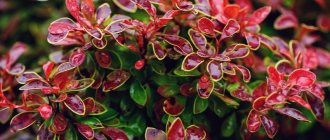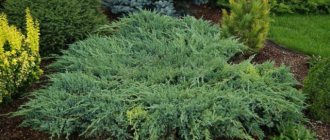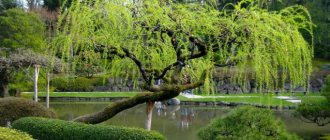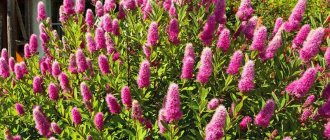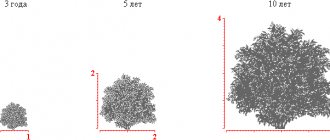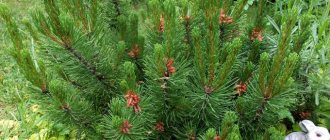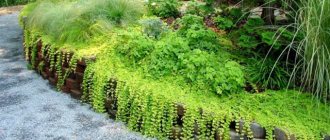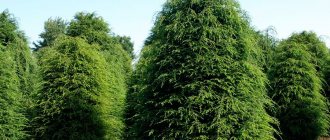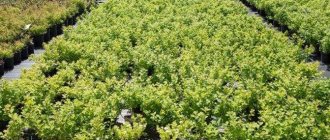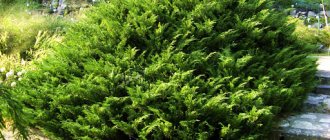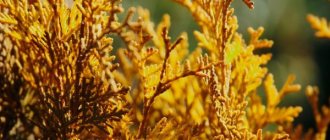Botanical description
Blue Swede (Juniperus squamata Hunnetorp) is an evergreen, slow-growing compact shrub of the Cypress family, with an annual growth of no more than 8 cm. At the age of ten, its dimensions reach 0.5 m in height and 1 m in crown diameter. The maximum that is typical for him is 1.5x2.5 m.
The young bush has a pillow-shaped crown with branches growing parallel to the ground.
During the growth process, the direction changes, the shoots rush upward, and their ends hang down, creating a weeping shape. The length of the needles is up to 0.1 cm, it is hard and prickly. In the spring-summer period, the needles are painted bluish-green; in the cold season they are silvery.
The fruits are round-shaped cones, deep blue in color with a bluish coating, up to 9 mm long. The shoots of young specimens are green; the needles on them are not densely located. As they grow, the branches become long and turn brown and have a scaly structure.
Important! Juniper needles and branches contain toxic substances, so if plant sap gets on your skin or mucous membranes, you should immediately rinse the damaged area with plenty of water.
Blue Swede (aka Blue Swede or Swede) has a deep, weakly branched root system. On heavy soils - superficial, weakly fixed, does not tolerate gusts of wind, but is resistant to frost. The variety is not demanding on soil fertility and develops well in urban conditions (smog, etc. air pollution).
Reproduction
Rock juniper can be propagated by seeds or cuttings. Gardeners, as the easiest method, often choose the cutting method. To do this you need:
- cut off young shoots in spring;
- clean them from the needles from below;
- treat with a rooting stimulating agent;
- place in a box filled with peat substrate;
- transfer the box to a greenhouse, where the air temperature is from 18 to 23 degrees Celsius;
- in the fall, after complete rooting, young seedlings are transplanted into separate containers.
In this way, the Blue Arrow variety can be grown for 2-3 years, and then transplanted to an open place. During the entire period of growth of juniper in a container, it is necessary to provide watering as the soil dries out.
Propagation by seeds is not popular, as this process is very long and labor-intensive. It takes about 5 years and does not always end successfully.
Landing
Juniper, like most of its relatives, can reproduce in three ways:
- layering;
- seeds;
- seedlings (grown by cuttings).
The latter option is more practical (high survival rate, preservation of varietal qualities, etc.). This is the landing we will talk about.
Important! Nitrogen-containing fertilizers (manure, compost, etc.) are not used to feed junipers, as they provoke the development of fungal infections.
Planting should be done in the spring, when the soil is warm and there are no frosts. Choose a sunny place with light shading. The plant is drought-resistant, so the soil should be moderately moist, not saline with a slightly acidic or alkaline reaction. Close passage of groundwater is not allowed. Clay soils are corrected with sand and wood ash (2 tbsp./1 m²), alkaline soils with lime (up to 200 g/1 m²).
Special attention should be paid to planting material.
You need to purchase it only from farms specialized in growing coniferous species. The seedling should be in a container, the roots should not come out, the needles should be of a rich color without spots or plaque, and not dry. The shoots are flexible, the bark is not damaged. There should also be no resin leaks.
Also find out when is the best time to replant juniper to a new location.
Planting stages:
- Prepare a planting mixture (turf soil, sand, peat in a ratio of 1:1:2) and a drainage layer (brick fragments, coarse sand, pebbles, etc.).
- When planting in groups, the distance between bushes should be at least half a meter.
- Dig a hole at least 2 times larger than the earthen ball, but at least 70 cm deep and wide.
- Place a 20-centimeter layer of drainage on the bottom, and cover one third with planting mixture on top.
- Moisten the soil in the container with the seedling and in the planting hole.
- After absorbing the liquid, carefully remove the plant along with the lump of earth and move it to the center of the recess.
- Fill with soil mixture and compact, while the root collar should remain at ground level.
- Then make a circle around the trunk, pour in 5–7 liters of water and apply a mulching (protective) layer of wood chips, leaves, peat, etc., about 7–10 cm high.
In the first week after planting, the plant needs daily watering.
Common diseases and pests
If you strictly follow all the recommendations, the tree will grow healthy. But there are still cases when it succumbs to certain diseases. Most often, this shrub suffers from diseases such as:
- Schutte brown;
- rust;
- drying out of branches.
Schutte brown is a very dangerous disease. The word “schutten” comes from the German language and translated means to crumble. And this is true; the needles of affected plants first turn yellow, die, and then fall off. The fact that the plant is sick is indicated by the brown-brown tint of the leaves, which appears on them at the beginning of summer, and after some time black dots form.
Weak shrubs, as well as those growing in excessively wet soil or in the shade, are susceptible to this disease.
To overcome brown shutte, you need to cut off all damaged branches, remove foliage and treat the bush with a product such as Quadris or Strobi.
The next no less dangerous disease is rust. Its causative agent is basidiomycetes. The affected plant is distinguished by a swollen stem, on which bright orange growths form over time. Rust is dangerous not only because it spoils the aesthetic appearance of the shrub, but can also lead to its death.
Important! If the branches are affected by rust, then they already need to be pruned, since they cannot be treated. Secateurs must be disinfected so as not to spread spores
The remaining areas of the bush are treated with fungicides.
Rust is easier to prevent than to treat. Therefore, to be on the safe side, it is necessary to treat the plant several times with Vectrom or Bayleton.
Drying of branches can also lead to the death of shrubs, the causative agent of which is a variety of pathogenic fungi. The cause of this disease is dense planting and heavy soil. The affected branches are cut off, and the bush is treated with fungicides, such as Skor and Tilt.
As for pests, juniper scale insects and moths, as well as aphids and mealybugs, like to feast on the bush. Actellik, Enzhio, Caesar and Aktara have proven themselves well in the fight against these parasites.
If you need to diversify the landscape near your house, or the task is to decorate an entire park, then you should definitely pay attention to the Pfitzerian juniper. It looks good against the backdrop of pines, firs and spruces
Of course, juniper, together with flowering shrubs, will change the landscape design simply beyond recognition.
Juniper care
Blue Sweet does not require any special gardening skills.
Simple agrotechnical techniques are sufficient for the variety to develop well, namely:
- watering during the dry period requires moderate but regular watering (avoid stagnation of liquid under the bush);
- after irrigation, the soil must be loosened (a mulch layer will help to avoid this);
- at least once every 7 days it is necessary to spray the needles with warm water from a spray bottle (after sunset);
- in April – May, “Nitroammofoska” ( 30–40 g/1 m² );
- biennial plants are fed in the spring with complex mineral supplements for coniferous plants ( Biopon , Actiwin ), 30–40 g per bush, followed by loosening and watering;
- pruning is only necessary for sanitary purposes (withered and broken branches are removed), sometimes they resort to formative pruning (if a new shoot spoils the appearance of the bush). After the procedure, the cut sites are treated with garden varnish;
- in the first year after planting, the plants are covered with spruce branches for the winter, and in subsequent years the shoots are tied together to avoid damage during heavy snowfalls.
Did you know? The Moscow region coal basin was discovered thanks to juniper. After all, its thickets often form near the occurrence of coal seams.
This variety can occasionally be affected by fungal rust and gray mold . To avoid diseases, you should adhere to the recommended distance between the bushes, and also, for prevention, spray the needles with copper-containing preparations (Hom, Abiga-Peak) in early spring and autumn.
If infection cannot be avoided, damaged shoots are removed and disposed of outside the site, and the plants and soil around them are treated with the fungicide Oxyx and Bordeaux mixture. Use according to the instructions for the drug.
When affected by scale insects and moths, spray with insecticides (“Aktara”, “Aktelik”). Acaricidal drugs (Apollo, Envidor) are used against ticks.
Another significant problem for juniper is sunburn. They are easily distinguishable: in early spring, on one side the needles turn yellow, the ends of the shoots dry out. This phenomenon spoils the decorative appearance of the plant, so damaged parts must be removed.
Did you know? Cabinets made of juniper wood do not harbor moths.
An autumn cover with a material (agrofibre) that allows air to pass through will help solve the problem, or with the arrival of spring, sprinkle the snow under the bushes with earth, peat or sawdust, because it is the reflection of the sun's rays from the snow cover that leads to burns.
Decorative properties
The type of shrub in question is intended to create the design of plant recreation areas within the boundaries of a suburban area. In addition, this ornamental plant is an ideal planting material used to decorate miniature rock compositions (alpine slides, in particular).
On a note. Taking advantage of the plantings of juniper creeping along the ground, it will be possible to create a beautiful lawn in the area adjacent directly to the garden house.
In the final part of the review, we note that this type of ornamental crops harmonizes perfectly with the lush rose bushes growing nearby, as well as flower beds of other garden flowers, decorated with light pebbles.
In addition, a separate bush can be planted in a massive pot, for example, which is then used as a decorative element decorating a balcony or wall of a house.
